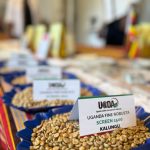The Brazilian Drought Situation
 A relatively unknown weather phenomenon is causing problems to Brazil’s Southeast water supplies as well as various agricultural products, including coffee.
A relatively unknown weather phenomenon is causing problems to Brazil’s Southeast water supplies as well as various agricultural products, including coffee.
A center of high pressure has been stationary over the coffee belt since late November 2013 and is expected to stay there until the 20th of February when rains are expected to resume. The only recent parallel to this situation that I recall goes back to 1985 when the drought over the coffee regions also started in November of the previous year, 1984. In that event, the rains only resumed by November 1985 and Brazil only produced 11 million bags in 1986.
Hopefully, this time rains will return in a sufficient quantity and the losses will be minimum.
Some facts that may help to follow the situation day by day:
– Brazil’s rainy season over the entire coffee belt starts in October and runs into April of the new year,” this is the flowering, fixation, fruit growth and maturation period”.
– From May through late September, the weather is mostly dry, “this coincides with the harvest season”.
If the coffee trees suffer from extreme lack of rain and high temperatures for a prolonged period, this is how it reacts:
– The tree will react on a sequential format, always aiming to protect the hanging fruit and the future flower gems.
– If the rains stop in late November (previous year), the trees will slow down the new branch area growth where flower gems will form and where new production concentrates for the next harvest.
– If the rains remain short with low air humidity and high temperatures during December and January as was the case this year, the bean growth reduces and the outer leafs begin to scorch and bend downward.
– By end of February, if rains still remain absent, all leafs will bend downward and eventually drop, the fruit growth becomes stagnant and the tree adopts a hibernating by stress behavior. Lack of rain will also neutralize the absorption of the fertilizers and crop protection applied, this opens the window for plagues and weakening of the plant strength.
– By end of March, if rains do not return, the fruits begin to dry while hanging and eventually will also drop to the ground.
– By end of April, the normal dry cycle will begin and if it continues to be dry, an early harvest of smaller size beans containing an abundance of dry unripe fruits will have to start. At this time, an un-leafed tree, stressed by drought and direct sunlight will not have means to protect the lesser surviving flower gems and the next crop will suffer a dramatic reduction.
At this time and through February 2014, most of the negative effects of severe drought can be reversed if rains become abundant from late February through mid-May.
The only negative factors that will remain are:
– Smaller bean size
– Lesser productivity for the 2015/16 crop as the branch growth has been lesser than normal and even with rains in late February, new growth will be reduced.
– Limited loss of quality due to various external disease attacks such as Broca, Bicho Mineiro, Rust etc.
Christian B. Wolthers











